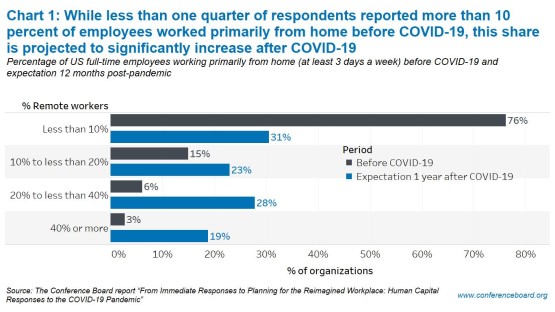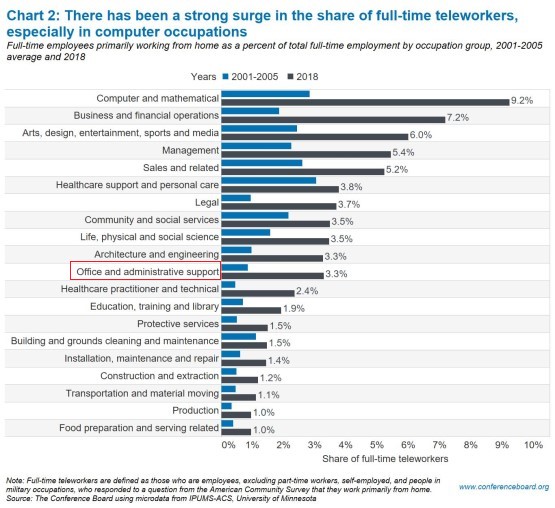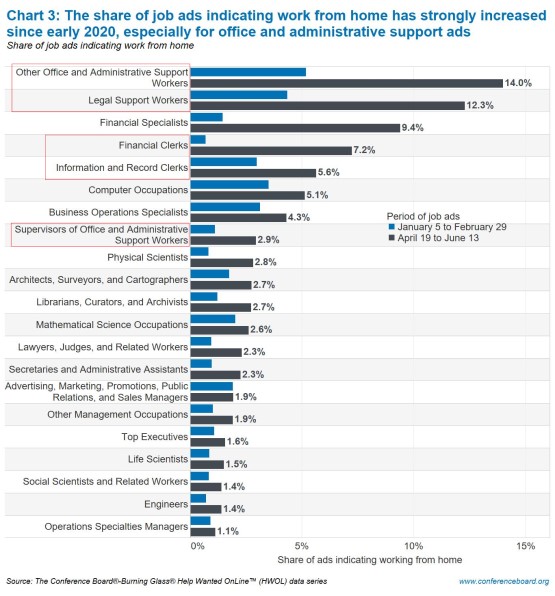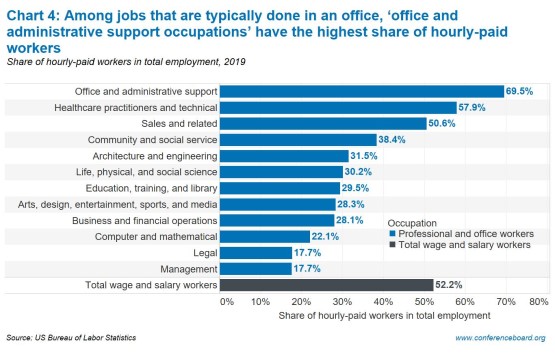-
Email
Linkedin
Facebook
Twitter
Copy Link

Loading...
There is a growing consensus that the share of remote workers will remain well above pre-pandemic rates. But in what types of jobs is this most likely to happen? We project a large increase in remote-working rates for clerical and administrative office jobs, a labor market segment which had relatively low remote-work rates in the pre-pandemic era. During the peak of the COVID-19 lockdowns, most US office workers labored primarily from home and few now expect a total return to the office. An April Conference Board survey conducted of human resources executives, for example, found that less than one in ten organizations had more than 20 percent of their staffers primarily working from home before the pandemic. But almost half of the survey respondents anticipated that more than 20 percent of their workforce will be primarily working from home 12 months after the pandemic ends (Chart 1). Which jobs are likely to see the greatest such change? One hint comes from pre-2020 remote work trends. They show that the share of full-time teleworkers differs widely across occupations (Chart 2). Pre-pandemic, most acceleration occurred in high skilled white-collar occupations. The fastest growth was in computer-related occupations, rising from about 3 percent in the early 2000s to over 9 percent in 2018. Business, financial, and management occupations also experienced rapid growth in teleworking. Interestingly, office and administrative jobs were rarely done primarily from home. Even in 2018, work-from-home rates in these occupations were well below those in professional office-related jobs. Online job ads provide another hint about which jobs are moving to remote working environment. The Conference Board®-Burning Glass® Help Wanted OnLine™ data series collects millions of online job ads in real-time and classifies them, among other things, by occupation. In addition, a keyword-based algorithm identifies job ads that allow candidates to work from home on some basis. Using this information, we can document trends in the willingness of employers to allow working from home by occupation. In general, there has been a large increase in the share of office jobs that allow working from home in recent months. Chart 3 shows the share of ads indicating work from home by occupation group for two periods: the eight weeks ending in February 29th (pre-pandemic) and the eight weeks ending in June 13th. The increase was most noticeable in clerical and administrative office jobs, that typically do not require a bachelor’s degree. There were several reasons why clerical/admin office workers were less likely to work from home. The main one was that many of them are hourly/non-exempt workers (eligible for over-time pay), which creates complications in a remote work environment. The nature of hourly/non-exempt office workers complicates the relationship where, under the Fair Labor Standards Act, employers are required to regularly document their hours worked each day and total overtime earnings. Without formal policies or procedures in place outlining and tracking non-exempt employees’ hours of work and performance, employers can create employment law compliance issues or be open to liability. In an employer survey conducted by WorldatWork, more than 50% of respondents indicated their organization does not have policies and programs in place for non-exempt workers, including at-home inspection and return-on-investment analysis. Many of these non-exempt workers are low-skill and low-wage where many employers were unwilling or unable to invest the time and money needed to effectively transition them to telework. Before COVID-19, many organizations offered telework on an ad-hoc basis, where working from home was viewed as an exception. According to the employer survey conducted by WorldatWork, 44% of respondents reported that they do not have a formal selection process in place to determine who should or should not work remotely.[1] Additionally, a large percentage of clerical/admin office jobs are concentrated in traditionally more conservative industries such as government, law, and insurance. Workplace culture along with lagging innovation may have been a barrier to working from home, a privilege often reserved for high-skilled, salaried workers. These issues were not insurmountable but they created significant barriers. COVID appears to have smashed these barriers as the lockdowns forced companies to deal with these issues. This may be the beginning of a new trend, a massive shift to remote work for these jobs. Among jobs that are typically done in an office, ‘office and administrative support occupations’ have by far the highest share of hourly-paid workers – about 70 percent (Chart 4). Those jobs typically do not require unique skills, and candidates for these positions are available in large numbers in most geographies. For employers concentrated in expensive metro areas like San Francisco and New York City, shifting these jobs to remote workers in less expensive geographies in, and outside, the US, could result in significant labor cost savings. A large majority of clerical and administrative office workers are women, so a shift to remote working may help to raise their labor force participation rates, as it could allow some of them that now don’t work at all due to family care responsibilities, to be more connected to the labor market. Job losses in retail, food services, and education sectors have predominantly affected women, so a change of the clerical and administrative work situation could benefit those who have lost their jobs in other industries.




March Payrolls: The Calm Before the Tariff Storm
April 04, 2025
February Jobs Report Hints at Growing Uncertainty
March 07, 2025
Q4 ECI Wage Deceleration Slows
February 07, 2025
Stability Underneath January’s Noisy Jobs Report
February 07, 2025
Robust Job Gains Close 2024
January 10, 2025
November Job Gains Rebound from Disruptions
December 06, 2024
Charts
Measure which job titles in corporate America become more or less popular over time.
LEARN MORECharts
how employers are reacting to shifts in the labor market and the ways in which they are working to combat the labor shortage
LEARN MORECharts
There has been a large increase in the share of office job ads that mention remote work since before the pandemic.
LEARN MORECharts
certain skills and groups of skills have grown more rapidly in demand, identifies individual skills mentioned in online job ads and groups them into clusters
LEARN MOREPRESS RELEASE
Online Labor Demand Increased in March
April 09, 2025
PRESS RELEASE
Report: How Employers Combat Labor Shortages
December 08, 2021
All release times displayed are Eastern Time
Using Bonuses To Attract New Workers
September 14, 2021 | Chart
Skills Growing in Demand for Tech Jobs
March 11, 2021 | Chart
The economy is struggling to keep up with the rise in coronavirus cases
July 27, 2020 | Brief
What types of jobs will experience a large permanent increase in remote working?
July 13, 2020 | Brief
